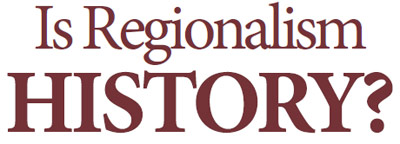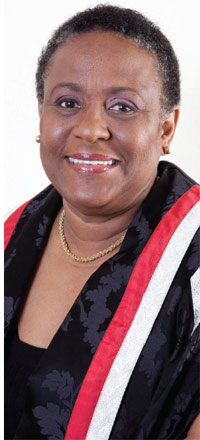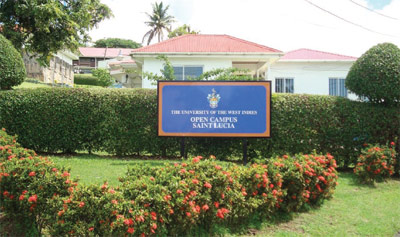 |
 |
 |
|
May 2011
|
 
By Professor Hazel Simmons-McDonald
The aphorism takes on particular significance when we review the circumstances that led to the demise of the Federation and our staggered efforts to create unity of Caribbean states through CARICOM and a “Single Market Economy.” In this context we may well ask whether inertia has become so inbred in our modus vivendi (and operandi) that we cannot generate the political will necessary to drive us towards a union that is manifested in ways more tangible than periodic meetings of heads of government where the same subjects are rehashed and decisions postponed to subsequent meetings in a cycle of deferrals and indecisive action. The point has been made that it took European countries several decades to forge an economic and political union in which a system for free trade and common external tariffs is negotiated. The implication is that we probably expect too much from a relatively young CARICOM. But have we wisely used the lessons from our history to capitalise on opportunities to design the architecture for a political and economic framework of a regional bloc that would have the strength of voice and vote in the global marketplace to negotiate better terms for each and all? History teaches that we may not have done so, and history demonstrates that we have actually lost ground by pursuing policies formulated within the scope of narrow national perspectives that inhibit gains to the collective and individual states within it. In the Eleventh Sir Archibald Nedd Memorial Lecture, Sir Shridath Ramphal cites several examples from history that illustrate how and where we have fallen short and why political decisions continue to hinder our economic development. However, even as he delineates the pitfalls that have resulted from the lack of a robust political and economic cohesion, he acknowledges, as we all do, the existence of a regional identity ingrained in the collective psyche, and which leads us to celebrate or lament the successes or failures respectively of the West Indian cricket team. It is also that sense of a West Indian identity that cautions against the further erosion of The University of the West Indies (UWI) as a regional institution. West Indies cricket and The UWI continue to be regarded by many as regional establishments. The waning fortunes of WI cricket have resulted in some disaffection among our publics if not ardent fans. Likewise, the duplication of professional Faculties has created the perception that The UWI is now less of a regional institution than it once was; that it has become fragmented and approximates three national universities in countries with established campuses; that it created an Open Campus intended to be primarily virtual and to serve countries without established campuses, but which is held at arm’s length and regarded with a large dose of scepticism in certain quarters in the University. The duplication of certain professional Faculties and programmes on the three established campuses has been undertaken in the climate of a world recession and it has become increasingly difficult for some students to travel to a campus outside their home country. The result of this is the population at a given campus tends to comprise mainly students from that country and the rich cultural blend when students from different parts of the Caribbean gathered at one campus to study has been diluted. The incursion of foreign institutions into the educational landscape as well as very aggressive marketing and promotion strategies by foreign universities to attract students to study abroad have also affected the UWI student population overall. Many students who may have selected one of the UWI campuses now study in the United States and elsewhere if they can afford to do so or if they get scholarships. The education landscape is now very competitive and UWI has to make certain adjustments if it is to attract a fair market share across the region. We learn from history that the evolution of The UWI has been positive and one might say meteoric, if one considers that a mere 62 years ago the institution started as a college at Mona with just a handful of students enrolled to study medicine, and today over 40,000 students are enrolled at its various campuses. Recent trends also indicate that when The UWI is considered as a regional institution, its ranking among world and regional universities is higher than if ranking was based separately on the performance of individual campuses. This is a positive indicator for the institution to preserve a regional identity. Unfortunately, changes in the governance structure have tended to erode the regional framework. For example, year-end cross-faculty meetings were discontinued, resulting in increased variation in courses with identical codes and titles. The effect on students has been negative if credit is denied for some of these courses when students seek transfers from one campus to another. UWI has taken some steps to foster regionalism, such as the establishment of centres that draw on the expertise of staff across the campuses. It has also created a Millennium Fund to facilitate student exchanges across campuses and the proposal for one virtual space promises to create a cohesive framework for the institution. Yet, much more needs to be done if The UWI is to reshape itself into a harmonised and collaborative entity. As examples, I will mention four points in summary from among several that merit consideration.
Second, in its marketing thrust The UWI needs to present itself to the world as unified, organised and cohesive. A distorted view of The UWI is presented when advertisements speak to the benefits of attending one specific campus. The UWI might consider forming a unit that will consider promotion of all its campuses from a unified perspective that highlights the particular strengths of the several parts and the benefits to be derived from them. Third, the entire region would benefit if The UWI formed productive and mutually supportive partnerships with national colleges and help to build a network for higher education that would make for (i) capacity building; (ii) a shared platform for delivery of courses virtually based on an appropriate model for cost and revenue sharing and with the application of approved quality standards; (iii) facilitating 2+2 arrangements that allow students with the required qualifications to transition seamlessly from college to university; (iv) partnerships with the public and private sector to provide lifelong learning opportunities for workers and to ensure their continued employability; (iv) making available, through the Open Campus, a wider slate of courses and programmes that address the needs of the communities UWI serves. Fourth, in creating an Open Campus, The UWI sought to respond more effectively to the needs of countries in the UWI-12 and underserved communities. It was also considered that the OC by virtue of its scope and reach would bring University services to people in communities across the region without access to a university education. In so doing, the OC would itself provide internal cohesion through ongoing collaboration with the established campuses to provide a slate of quality UWI courses to the world. To realise this, an attitude of acceptance of The UWI Open Campus would be more productive than one of rejection and ostracism. Considering the current economic climate as well as the several changes in The UWI over the last few years, it is impractical to expect that the experience of regionalism is going to be exactly as it was some decades ago and about which alumni speak with nostalgia. While this may be so, it is important to ask whether regionalism must be accepted as history – a thing of the past – or whether The UWI can draw on its considerable resource of gifted and creative intellectuals to fashion a model of regionalism that is sustainable and that will make it much stronger. Perhaps recent histories of institutions similar in some respects to UWI (e.g. Global Campus, Urbana Illinois) might teach us how a more inclusive posture and harmonious environment would strengthen the institution as it transforms itself to utilise technologies that position it to continue to be relevant in a rapidly changing educational environment and to respond more effectively to regional needs. |

 In a recent conversation about regionalism a colleague observed that, “History teaches that history does not teach.” Another colleague, interpreting the statement literally, thought it paradoxical and untrue because in his view the business of History is to teach and he could think of no circumstance in which History does not teach. He was right in the sense that the business of History, the subject, is to teach by presenting a record of the events related to human and public affairs across time. Yet the statement can also be understood to acknowledge that we do not always learn from the events and circumstances of the past (the history) and use our understanding of those events to avoid making the same or similar mistakes in the present; or even, that we do not use the very rich analysis of the events presented to us formally in History to shape a different circumstance in the present. In this sense it would be true to say that History does teach that history does not teach, or, that we do not (always) learn from history.
In a recent conversation about regionalism a colleague observed that, “History teaches that history does not teach.” Another colleague, interpreting the statement literally, thought it paradoxical and untrue because in his view the business of History is to teach and he could think of no circumstance in which History does not teach. He was right in the sense that the business of History, the subject, is to teach by presenting a record of the events related to human and public affairs across time. Yet the statement can also be understood to acknowledge that we do not always learn from the events and circumstances of the past (the history) and use our understanding of those events to avoid making the same or similar mistakes in the present; or even, that we do not use the very rich analysis of the events presented to us formally in History to shape a different circumstance in the present. In this sense it would be true to say that History does teach that history does not teach, or, that we do not (always) learn from history.  First, the governance structure of the University has to be reviewed to allow for a collaborative and not a competitive co-existence among the four campuses. As Sir Shridath has pointed out, our history should teach that the lack of a common foreign policy or lack of adherence to an existing one can lead to the perception of the region as being scattered and uncoordinated. Similarly, if The UWI has created policies to guide delivery of programmes by its campuses, then it is counterproductive if different campuses ignore the policy and negotiate with various entities to offer the same or similar courses at the same location. When this happens, The UWI is perceived as an institution in which its entities compete against each other, and in fact it is UWI competing with UWI.
First, the governance structure of the University has to be reviewed to allow for a collaborative and not a competitive co-existence among the four campuses. As Sir Shridath has pointed out, our history should teach that the lack of a common foreign policy or lack of adherence to an existing one can lead to the perception of the region as being scattered and uncoordinated. Similarly, if The UWI has created policies to guide delivery of programmes by its campuses, then it is counterproductive if different campuses ignore the policy and negotiate with various entities to offer the same or similar courses at the same location. When this happens, The UWI is perceived as an institution in which its entities compete against each other, and in fact it is UWI competing with UWI.